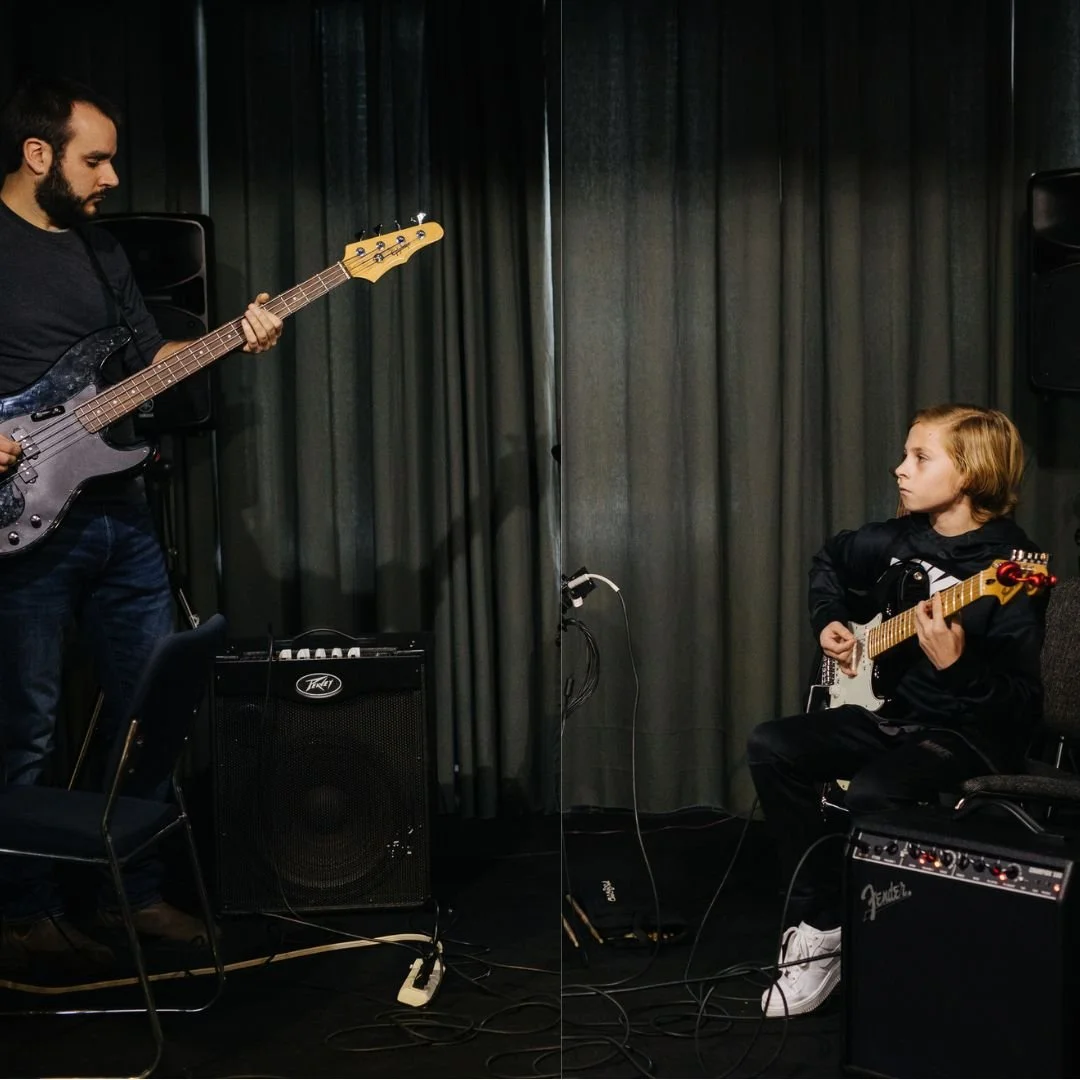Differences Between Bass Guitar, Electric Guitar, and Acoustic Guitar
Bass Guitar vs. Electric Guitar vs. Acoustic Guitar
The bass guitar, electric guitar, and acoustic guitar are three of the most popular stringed instruments, each playing a unique role in music. While they may look similar, they differ in sound, function, technique, and playing style. If you're wondering which one to choose or just want to understand their differences, this guide will help break it down.
Read our blog if you want to learn How to Play Guitar. Tips for Beginner Guitarists.
1. Size, Structure, and Strings
Bass Guitar
Larger body with a longer neck (typically 34-inch scale).
Features thicker strings for deep, low-end tones.
Typically has four strings (E-A-D-G), but five- and six-string models exist for extended range.
Designed for low-frequency support in a band setting.
Do you want to learn more about the different types of bass guitars, read here.
Electric Guitar
Smaller, lighter body with a shorter neck (typically 24.75–25.5 inches).
Features lighter, thinner strings, making it easier for fast solos and chord changes.
Most commonly has six strings (E-A-D-G-B-E), but seven- and eight-string models exist for expanded tonal range.
Requires an amplifier to produce sound effectively.
Acoustic Guitar
Has a hollow wooden body that naturally amplifies sound.
Features six strings (E-A-D-G-B-E) with heavier gauge strings than an electric guitar.
Doesn’t require an amplifier to be heard but can be equipped with electronics (acoustic-electric models) for amplification.
Larger than an electric guitar but smaller than a bass guitar.
2. Sound and Tuning
Bass Guitar
Produces low-end frequencies that form the rhythmic and harmonic foundation of a song.
Tuned an octave lower than a standard electric guitar.
Standard tuning: E-A-D-G (same as the lowest four strings of a guitar but deeper in pitch).
Works closely with the drums to drive the rhythm.
Electric Guitar
Produces a wide range of tones, from clean melodies to heavy distortion in rock and metal.
Standard tuning: E-A-D-G-B-E (more range for chords and solos).
Can be shaped with effects pedals for unique sounds (distortion, reverb, delay).
Requires an amplifier to project its sound effectively.
3. Role in a Band or Performance
Bass Guitar
Acts as the backbone of a band, providing rhythm, groove, and depth.
Works closely with the drummer to maintain a steady beat.
Usually plays single-note lines rather than chords.
Essential for rock, funk, jazz, blues, metal, and pop.
Electric Guitar
Can serve as both a lead and rhythm instrument.
Takes a more prominent role in a band’s sound, playing melodies, solos, and power chords.
Essential in rock, metal, jazz, blues, punk, and pop.
Often the most expressive instrument due to effects and amp settings.
Acoustic Guitar
Ideal for rhythm playing in folk, country, pop, unplugged rock, and singer-songwriter music.
Can be played as a solo instrument for singing and strumming.
Often used for intimate performances, live gigs, and songwriting.
Doesn’t need an amplifier but may struggle to be heard in loud band settings.
4. Playing Technique
Bass Guitar
Primarily played with fingerpicking (index and middle fingers) or slap bass techniques for percussive effects.
Focuses on single-note grooves rather than full chords.
Requires strong rhythm skills to sync with the drummer.
Electric Guitar
Played with a pick or fingers, depending on the style.
Techniques include power chords, fast picking, tapping, bending, vibrato, and hammer-ons.
Can incorporate effects pedals (distortion, wah-wah, delay) for dynamic sound shaping.
Acoustic Guitar
Played using fingerstyle or a pick.
Common techniques include strumming, fingerpicking, and percussive tapping.
More physically demanding due to higher string tension.
5. Effects and Amplification
Bass Guitar
Uses bass amps specifically designed for low frequencies.
Effects include compression, overdrive, and chorus for added texture.
Electric Guitar
Requires a guitar amp for projection.
Uses a wide range of effects pedals, including distortion, delay, reverb, wah-wah, and flanger.
Acoustic Guitar
Doesn’t require an amplifier but acoustic-electric models can be plugged into PA systems or acoustic amps.
Minimal effects are used (reverb, chorus).
6. Popular Music Genres
Electric Guitar
Rock (power chords and solos).
Metal (heavy distortion and fast shredding).
Jazz (smooth, melodic playing).
Blues (bending and expressive vibrato).
Country (twangy leads and fingerpicking).
Acoustic Guitar
Folk (fingerpicking and soft melodies).
Country (open chords and storytelling).
Pop (accompaniment for vocals).
Unplugged Rock (acoustic versions of rock songs).
If you are curious about different guitar genres read here.
Which One Should You Choose?
🎸 Choose the Bass Guitar If:
✔ You enjoy groove and rhythm over flashy solos.
✔ You like playing with a band’s rhythm section.
✔ You want to be the foundation of a song’s harmony.
🎸 Choose the Electric Guitar If:
✔ You love playing solos, riffs, and power chords.
✔ You want to experiment with effects and amplification.
✔ You’re interested in rock, metal, blues, or jazz.
🎸 Choose the Acoustic Guitar If:
✔ You love the natural, unplugged sound.
✔ You enjoy singing and playing along.
✔ You want an instrument that’s portable and doesn’t require an amp.
Each instrument has its unique sound, technique, and role in music. No matter which one you choose, you’ll have an exciting musical journey ahead!
Whether you're interested in bass, electric, or acoustic guitar, our guitar instructors at NUVO Music School are ready to share their extensive knowledge and help you learn.
NUVO Music School offers in-home and online guitar lessons across British Columbia, including Langley, Surrey, White Rock, and Delta, as well as select areas in the Prairies, such as Saskatoon, Regina, Edmonton, Calgary, and Winnipeg.



